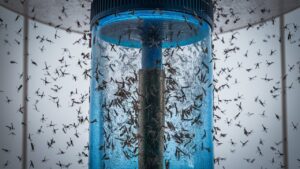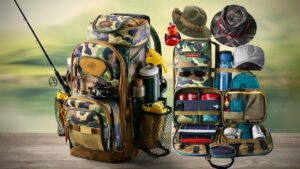To use a fishing light to attract more fish, place the light in the water. The light will draw plankton, which attracts small fish, which then attract bigger fish.
Fishing lights are a fascinating tool for anglers of all levels. They can significantly increase your chances of a successful catch. Fish are drawn to the light because it mimics the natural conditions they thrive in. This method is simple yet effective, making it a favorite among many fishing enthusiasts.
Whether you are fishing in a lake, river, or ocean, understanding how to use a fishing light can transform your fishing experience. In this guide, we will explore the steps and tips to maximize your use of fishing lights. Get ready to enhance your fishing skills and enjoy more productive trips.
Introduction To Fishing Lights
Fishing lights are valuable tools for anglers. They attract fish during nighttime fishing trips. These lights illuminate the water, drawing various fish species closer. Understanding how to use fishing lights can improve your fishing experience.
Purpose Of Fishing Lights
Fishing lights serve several purposes. They attract fish by mimicking natural light sources. This light lures smaller organisms, which in turn attract larger fish. The lights also improve visibility for anglers.
Using fishing lights can increase your chances of catching fish. They create a feeding frenzy, making it easier to catch fish. Fishing lights are useful for both freshwater and saltwater fishing.
Types Of Fishing Lights
There are different types of fishing lights available. Each type has its benefits and best uses. The main types include submersible lights, floating lights, and black lights.
Submersible lights are placed below the water surface. They are effective for attracting fish at various depths. Floating lights stay on the water surface. They are easy to use and good for shallow waters.
Black lights are used for night fishing. They make certain materials glow, making it easier to see. Each type of fishing light can enhance your fishing experience in different ways.
Benefits Of Using Fishing Lights
Using fishing lights can significantly boost your fishing experience. These lights attract fish, making it easier to catch them. Fishing lights also improve visibility, helping you see better in low-light conditions. Let’s explore the benefits of using fishing lights in more detail.
Increased Fish Attraction
Fishing lights draw fish to your area. The light attracts plankton, which in turn attracts small fish. Small fish then attract larger fish. This creates a feeding frenzy around your boat. You can cast your line right into the action. This increases your chances of catching more fish.
Enhanced Visibility
Fishing at night can be challenging. Darkness makes it hard to see your surroundings. Fishing lights brighten the water around you. This helps you see where you are casting your line. You can also see any fish swimming nearby. Enhanced visibility keeps you safe. It helps you avoid obstacles and dangerous situations.
Choosing The Right Fishing Light
Hey there, fellow anglers! Today, we’re diving into a topic that’s sure to light up your fishing trips—literally. We’re talking about choosing the right fishing light. Whether you’re a seasoned pro or just starting out, the right light can make a big difference. So, let’s break it down and make your next night fishing adventure a bright success!
Led Vs. Fluorescent
First up, let’s talk about the two main types of fishing lights: LED and fluorescent. Each has its own perks and quirks.
LED lights:
- Last longer – LEDs can run for thousands of hours.
- Energy efficient – They use less power, which means longer battery life.
- Bright – LEDs can be very bright, making them great for attracting fish.
Fluorescent lights:
- Cost-effective – Generally cheaper upfront.
- Soft light – Some fish are more attracted to the softer light emitted by fluorescents.
- Wider range – Fluorescents often have a wider light spread.
So, which one should you choose? If you want something durable and bright, go with LEDs. But if you’re looking for something budget-friendly and gentle, fluorescents might be your best bet.
Color And Brightness
Now, let’s talk about color and brightness. These are crucial factors when it comes to attracting fish.
Here’s a quick guide to help you out:
| Color | Best For |
|---|---|
| Green | Attracting plankton, which draws in small fish, and in turn, bigger fish. |
| White | General use, good for a variety of fish species. |
| Blue | Deep sea fishing, as blue light penetrates deeper into water. |
As for brightness, here’s the deal:
- Too bright can spook some fish.
- Too dim won’t attract enough plankton and baitfish.
- Find a balance – Bright enough to draw attention, but not so bright it scares them away.
I remember my first night fishing trip with a friend. We used a bright white LED light and were amazed at how quickly we attracted fish. It was like magic! But, when we switched to a green light, we caught even more. Turns out, the green light was better at drawing in the smaller fish, which brought in the bigger ones.
So, experiment a bit. Find what works best for your fishing spot and the type of fish you want to catch. Happy fishing!
Setting Up Your Fishing Light
Hey there, fellow fishing enthusiasts! Ever wondered how to get more fish during your night fishing trips? A fishing light might just be your secret weapon. Let’s dive into how you can set up your fishing light to attract more fish. It’s simpler than you think. Ready? Let’s get started.
Placement Strategies
First things first, where you place your fishing light matters a lot. Here are some easy tips:
- Near the Surface: Place your light close to the water surface. This helps attract small baitfish, which in turn attract bigger fish.
- Around Structures: Fish love hiding near underwater structures like rocks or logs. Position your light near these areas.
- Move It Around: Don’t just keep the light in one spot. Move it every now and then to cover more area.
Power Sources
Next, let’s talk about powering your fishing light. You have a few options here:
| Power Source | Pros | Cons |
|---|---|---|
| Battery | Portable, easy to use | Limited run time, needs recharging |
| Generator | Long-lasting, powerful | Bulky, noisy |
| Solar | Eco-friendly, cost-effective | Weather dependent, less powerful |
Choose the one that suits your fishing style best. Personally, I prefer using a battery-powered light. It’s simple and gets the job done without much hassle.
Setting up your fishing light is easy once you know the basics. Follow these tips, and you’ll be on your way to catching more fish in no time. Happy fishing!
Optimal Times To Use Fishing Lights
Fishing lights can greatly increase your catch. Knowing the optimal times to use them is crucial. Timing affects the effectiveness of fishing lights. Let’s explore the best times to use them.
Seasonal Considerations
Different seasons offer varying results with fishing lights. In warmer months, fish are more active at night. Use fishing lights during summer and spring for better results. Cold seasons like winter make fish less active. Use fishing lights in winter to draw fish out. Adjust your strategy based on the season.
Best Time Of Day
Nighttime is the prime time for fishing lights. Fish are attracted to the light in the darkness. Use fishing lights after sunset for best results. Early morning hours before sunrise also work well. Avoid using fishing lights during the day. Natural light reduces their effectiveness. Stick to dark hours for successful fishing.
Techniques For Maximizing Fish Attraction
Using a fishing light can significantly boost your chances of catching more fish. The right techniques are essential to maximize fish attraction. This section will explore effective methods to attract more fish using fishing lights. We will discuss light positioning and combining lights with baits.
Light Positioning
The positioning of your fishing light plays a crucial role in attracting fish. Place the light near the water surface. This attracts plankton, which in turn attracts smaller fish. Larger fish follow these smaller fish. Ensure the light covers a wide area for better results. Experiment with different depths to find the sweet spot.
Combining Lights With Baits
Combining lights with baits can enhance your fishing experience. Use bright lures that reflect the light. This makes them more visible and enticing to fish. Place baits near the light source. This increases the chances of fish noticing them. Live baits work well with lights too. The natural movement draws fish closer.
Safety Tips For Using Fishing Lights
Place your fishing light underwater to attract fish effectively. Ensure the light is securely attached to avoid accidents. Use waterproof and durable lights for safety.
Using fishing lights can greatly enhance your night fishing experience. They attract fish, making it easier to catch more. But, safety is crucial. Follow these guidelines to ensure a safe and enjoyable fishing trip.Handling Electrical Equipment
Always inspect your fishing light before use. Check for any damaged wires or broken parts. Ensure the battery is fully charged. Avoid using a damaged light. Electric shock can be dangerous. Keep your hands dry when handling the light. Wet hands can cause electrical accidents. Use gloves for extra safety. Make sure the light is turned off when not in use. Store it in a dry place.Environmental Precautions
Respect the environment while using fishing lights. Avoid shining the light directly at wildlife. This can disturb their natural behavior. Use the light only when necessary. Dispose of old batteries properly. Do not throw them into the water. They can harm the aquatic life. Follow local guidelines for battery disposal. Keep the fishing area clean. Remember, safety comes first. Enjoy your fishing trip with peace of mind. “`Maintenance And Care Of Fishing Lights
Hey there, fellow fishing enthusiasts! We all love our trusty fishing lights. They attract fish and make our fishing trips more successful. But, just like any other tool, they need proper care. In this section, we’ll talk about how to keep your fishing lights in top shape. Ready? Let’s dive in!
Cleaning And Storage
After a fun day of fishing, your lights might be dirty. Saltwater, mud, and fish scales can build up. This can affect their performance. Here’s a simple guide to cleaning and storing your fishing lights:
- Rinse with Fresh Water: Once you’re back, rinse the lights with fresh water. This removes salt and dirt.
- Use Mild Soap: If needed, use a mild soap. Avoid harsh chemicals. They can damage the lights.
- Dry Properly: Make sure to dry the lights completely. Use a soft cloth. This prevents rust and corrosion.
- Store in a Safe Place: Keep the lights in a cool, dry place. Avoid direct sunlight. This keeps the materials from degrading.
Troubleshooting Common Issues
Sometimes, even with good care, things can go wrong. Here are some common problems and how to fix them:
- Light Not Turning On: Check the batteries. They might need replacing. Also, inspect the connections. They should be clean and tight.
- Dim Light: If your light is dim, clean the lens. Dirt can block the light. Also, check the power source. It might be weak.
- Water Inside the Light: This is a big issue. Inspect the seals. They might be damaged. Replace them if needed. Always ensure the light is properly sealed before use.
Taking care of your fishing lights is easy. Just remember to clean them, store them well, and check for common issues. Happy fishing, friends!
Success Stories And Case Studies
Using a fishing light to attract more fish can be a game-changer for anglers. But don’t just take my word for it. Let’s dive into some success stories and case studies to see how effective fishing lights can really be.
Angler Testimonials
Many fishermen have shared their experiences with using fishing lights. Their stories show how these tools can make fishing trips more productive and enjoyable. Here are a few highlights:
- John’s Night Fishing Adventure: John used a green fishing light on his last night fishing trip. He noticed that within 30 minutes, fish started swarming around the light. He ended up catching twice as many fish as usual. He said, “It was like the fish were hypnotized by the light. They just kept coming!”
- Sarah’s Lake Experience: Sarah tried a blue fishing light at a local lake. She was skeptical at first but was amazed by the results. “I couldn’t believe how many fish were attracted to the light. It made my fishing trip so much more exciting,” she shared.
- Mike’s Success in Saltwater: Mike, an avid saltwater fisherman, used a submersible fishing light. He found that it attracted not only small fish but also larger predators. “The light drew in baitfish, which in turn attracted bigger fish. It was incredible!” Mike said.
Scientific Studies
It’s not just anecdotal evidence that supports the effectiveness of fishing lights. There have been scientific studies that back up these claims. Let’s take a look at some findings:
| Study | Findings |
|---|---|
| Marine Biology Journal | A study published in the Marine Biology Journal found that green and blue lights are particularly effective at attracting fish. These colors mimic the natural light environment underwater, making fish more likely to approach. |
| University of Florida Research | Researchers from the University of Florida conducted experiments with different types of fishing lights. They concluded that LED lights are the most efficient, as they produce more light and consume less power. |
| Fisheries Science Review | Another study in the Fisheries Science Review highlighted that using lights at different depths can attract different species. For example, shallow water lights attract small fish, while deeper lights can bring in larger predators. |
These studies show that the right type of fishing light can significantly increase your chances of a successful catch. Whether you’re fishing in freshwater or saltwater, using a green or blue light is a smart choice.
So, if you’re looking to boost your fishing game, consider trying out a fishing light. The testimonials and scientific studies both highlight how effective they can be. Happy fishing!
Frequently Asked Questions
How Do You Attract Fish With Light?
Use underwater LED lights to attract fish. The light mimics the moon, drawing plankton, which attracts small fish, and then larger fish.
What Color Of Light Will Attract Fish The Most?
Blue and green light attract fish the most. These colors penetrate deep into water, making them highly visible.
How To Use Fishing Light?
Attach the fishing light to your boat or fishing line. Turn it on at dusk to attract fish. Position it near the water’s surface for best results.
How Do You Attract More Fish?
Use fresh bait, attractant scents, and lures. Fish during peak times, like early morning or late evening. Select the right fishing spot.
Conclusion
Using a fishing light can increase your chances of catching fish. The light attracts fish by mimicking their natural prey. Choose the right light for your fishing environment. Place the light in the water and wait patiently. Fish will gather around the light, making it easier for you to catch them.
Experiment with different colors and intensities to see what works best. Fishing with a light is simple and effective. Give it a try on your next fishing trip for better results. Happy fishing!








